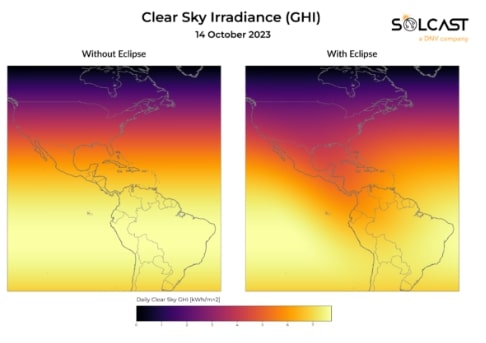
On October 14, A solar eclipse in North and South America is expected. During this eclipse, some states will experience a reduction of up to 17% in their daily solar energy production. The eclipse will start in the southwestern United States, then it will move from Oregon to Texas. Afterward, it will continue through Mexico, and Central America, and conclude in Brazil. However, its effects will be felt across the entire US and the northern part of South America.
In a solar eclipse, the moon does not fully cover the sun, unlike a total eclipse. Consequently, the sunlight won’t completely disappear, and the sky won’t become dark. When the eclipse passes over a region, the total clear sky irradiance will decrease to 9.5% of the normal levels. The entire eclipse will last around 3 hours in specific locations, but the peak darkness will only persist for a few seconds.
The eclipse’s peak time will start in Oregon at 9:20 a.m. local time. Afterward, it will pass over Northern California, Nevada, Utah, Arizona, and New Mexico, finally reaching Texas at 11:50 a.m. local time. The eclipse will hit Texas the hardest. This will occur during the middle of the day when solar energy production is typically at its highest. Consequently, some areas in Texas may observe solar energy production drop by as much as 17%.
Impact of Solar Eclipse on Solar Power Production:
This solar eclipse has the potential to affect power grids in the United States, such as CAISO and ERCOT. According to data from the U.S. Energy Information Administration, the most affected states collectively had 40.756 gigawatts (GW) of operational large-scale solar assets as of August 2023. Among these, Texas accounted for 13.046 GW, representing a substantial portion of the total capacity of large-scale Solar PV in the entire U.S., which stands at 80.368 GW.

The above graph shows there is quite a difference between total daily irradiance with and without the eclipse. The most substantial impacts are over Texas, the Gulf of Mexico, Central America, and Colombia. Texas may experience energy production losses of up to 17%, while Central America might see peak losses of 20%.
In South America, the eclipse will occur in the afternoon and evening hours. It will pass over the Yucatan Peninsula, traverse Central America, and reach Colombia before concluding in western Brazil at 4:20 PM local time. The eclipse will occur during or near the middle of the day when irradiance is highest. Therefore, the greatest energy losses are from Texas to Colombia. Conversely, Oregon, at the beginning of its day, and Brazil, at the end of theirs, are likely to experience proportionally lower daily losses.
SolarSME recommends solar homeowners in regions affected by the October 14 eclipse to be prepared by conserving energy during peak eclipse hours, considering backup power sources like battery storage, monitoring grid notifications for potential disruptions, and exploring additional energy storage solutions to mitigate the impact of reduced solar energy production during the eclipse.
News Source: PV Magazine
